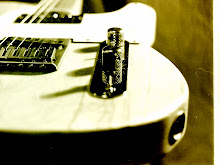
Then, in February – in further evidence of the young artist’s ascension from pretentious skate punk to feted member of the wine and cheese crowd – Fairey became the focus of a six-month-long exhibition at the Institute of Contemporary Art in Boston. With that, of course, came much fawning coverage in the local press. It didn’t hurt that right around the launch of the exhibit, the local district attorney’s office decided to exercise a several-year-old warrant for Fairey’s arrest on charges stemming from past “public exhibitions” of his work (i.e., prolific tagging of public and private property).
Beyond vaguely noting this increasing ubiquity of all things Fairey, I didn’t think much of – or much about – his art. Then, in April, with a friend in town and a few hours to kill, we decided to visit the new ICA building. It didn’t matter that we weren’t particularly interested in Fairey’s work, the much vaunted, relatively new facility itself was reason enough to wander down to the harborfront. And surely there’d be other stuff on exhibit, too.
There wasn’t. But, as I discovered, there was plenty to check out and even think about in Fairey’s works.
Now I’m no art critic, but after scrutinizing this extensive exhibit of Fairey’s art, including some of the biggest pieces I’ve seen in an exhibition (massive, wall-size canvases) I began to see some merit to his work. As derivative as it is – of Warhol, old Soviet- and Maoist-style propaganda and various mixed collage techniques – there’s also some originality in the stylizing and collaging, and most significantly in the wit and subversive juxtapositions.
I enjoyed watching a video interview in which Fairey talked about the art of graffiti and his efforts to keep his street cred as he navigates his way through the more high-falutin’ echelons of the art world. He explained his ongoing motivations for public “culture jamming” (the appropriation of public and commercial spaces for anti-commercial graffiti) to counter the fact that so many of our public spaces (or seemingly public spaces; i.e., in our sightlines even if on private property) are now used to inundate us with commercial messages. I liked the independence and subversiveness of his thought, though I’ll admit to likely feeling different about it if he was tagging my house!
Working my way through the extensive exhibition, I turned a corner and, amid a section of music-related images (rebel icons such as Johnny Cash, Joe Strummer, Henry Rollins, Tupac, et al,), I discovered a piece that was used as the cover of the most recent Led Zeppelin greatest hits collection, Mothership. As a big Zeppelin fan, this immediately drew my attention. At first I thought, “Is this some kind of a takeoff on the cover?” The band doesn’t quite fit in with most of the other pop icons he paid tribute to, and I had never heard elsewhere that Fairey had created this album cover – with his new celebrity status, you’d think this would have been mentioned somewhere. I inspected the piece closely. No, this was no hack, he had created the actual album cover. (It’s not really one of my favorite covers, but nonetheless …)

Another heretofore unknown association … and there was more to come. About a month ago, my eighth-grader was doing a book report that involved a posterboard component (doesn’t everything?) with a large hand-drawn rendering of the selected book’s cover. My daughter chose George Orwell’s 1984. She put a lot of effort into her report and especially her poster, spending hours hovering over it on the kitchen table. We were all very impressed with her final work – as was the teacher.
Then, a few days ago, what should I stumble across on the Web but the image of the 1984 cover that my daughter had so meticulously hand-copied. Only, unlike the black-and-white photocopy she had worked from and rendered in bright blues and greens, this one was in a familiar black, beige and muted red. Suddenly, I realized it looked very much like something by … you guessed it! It too was a Shepard Fairey creation. He had designed the cover she had replicated.
Wow, I thought, this is starting to get a little … I don’t know, eerie? What’s next? Will I find out that, unbeknownst to me, he designed the art for some magazine piece I oversaw years ago? Who knows? After all, Shepard Fairey is everywhere.






Frank and I also frequented the ICA a few months ago and checked out Fairey's work. As I took in all the Xeroxes and anti-capitalist propaganda (he's a STREET artist with cred, ya know!), I suggested to Frank that we should just take some stuff off the walls and walk out. I mean, Fairey would have been down with that, right?
ReplyDeleteNo, I think Shep's high-price security detail would have had us shackled before we made it past the $30,000 Sid Vicious portrait.